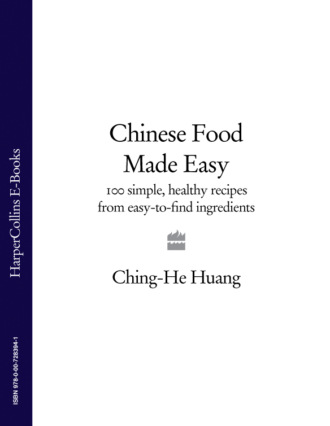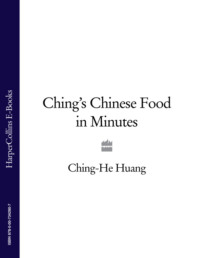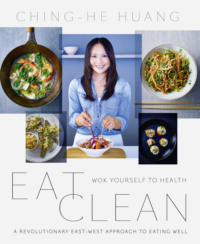
Полная версия
Chinese Food Made Easy: 100 simple, healthy recipes from easy-to-find ingredients

Chinese Food Made Easy
Ching-He Huang

Table of Contents
Title Page
Notes from a Chinese Kitchen
Takeaway Favourites
Spicy Sichuan Dishes
Dumplings, Dim Sum and Noodles
Fish and Seafood Dishes
Street Food
Celebration Food for Family and Friends
Desserts and Drinks
Side Dishes
Cooking Techniques and Storecupboard
Ching’s Menu Planner
Glossary
Notes for Cooks
Index
Bibliography
Acknowledgements
Copyright
About the Publisher
Notes from a Chinese Kitchen
FACT: TRADITIONAL CHINESE COOKING IS HEALTHY
When I first started to forge my TV career, it was difficult to break down the general perception that Chinese cuisine is unhealthy and bad for you. When most people in the UK think about Chinese food they almost always think of the local takeaways, some which are good but many of which are not. Monosodium glutamate (MSG), gloopy sugary sauces, deep-fried dishes laced with fat and salt – all dressed up as tasty, but in fact detrimental to one’s health. There are over 15,000 Chinese restaurants and takeaways in the UK, and some unfortunately perpetuate this image, but my hope is to dispel this notion and set the record straight.
With their research into thousands of years of Chinese history, historians confirm that Chinese culture derived from its food culture. Chinese are obsessed with food. For centuries, peasants and farmers struggled against famine, poor harvests, and floods. Out of this struggle, cooking techniques such as wok frying were invented, and preserving techniques such as drying, pickling and curing followed. To the Chinese, the genius of all inventions is the wok; the shape of it allows the food to be cooked on a very high heat with very little oil, and with rapid stirring and tossing, the wok cooks the food to perfection. This way of cooking sears the food on the outside, not only helping to create a slight smoky flavour but also retaining the nutrients in the ingredients for optimum health. The wok is also used for steaming (with the help of the bamboo steamer) as well as for braising, smoking and making soups – all healthy cooking techniques.
In fact, traditionally, when Chinese families go out to eat at a Chinese restaurant, just one fried dish, or none at all, will accompany the series of dishes ordered to be shared at the table. This was very much the case in my family, when I first grew up with my grandmother. In her kitchen, she would only ever deep-fry food if it was on its last few days of freshness! This method is a safe way of cooking leftover ingredients by heating them in hot oil and therefore killing off any possible bacteria (although if you think of this fact every time you eat fried food, it may just put you off). My grandmother was seriously opposed to ordering fried fish in restaurants – it implied the fish was not fresh and she would always insist on having it steamed instead. If the fish was not fresh, it would be overly fishy once cooked, because fresh fish when steamed should be odourless. However, I am not as strict as my grandmother when it comes to cooking or consuming fried foods. Of course, I would hope that all restaurants and takeaways use the freshest ingredients. To ensure that you are eating healthily, my advice is to cook the food yourself; and if you are dining out, then remember that keeping the balance right is key to good health and enjoying any cuisine – never too much of one thing is best for you.
In terms of balance, another important aspect of Chinese food is the philosophy of ‘yin’ and ‘yang’ – this is one of the foundations and principles of Chinese cooking. The belief is that all food has a ‘yin’ and a ‘yang’ element attached to it – ‘yin’ foods are cooling and ‘yang’ foods are heat giving. Traditionally, Chinese cooks would try to balance these foods in any one dish. ‘Yin’ foods include cucumber, fruits and most vegetables, while ‘yang’ foods are most meats, ginger, garlic and chillies. So a perfectly balanced dish might have a balance of meat and vegetables. Cooking techniques also impart a ‘yin’ or ‘yang’ element to a dish. Stir-frying and steaming are ‘yin’, whereas deep-frying is ‘yang’ – so if you deep-fry some vegetables, the dish is balanced overall because the vegetables are ‘yin’ and deep-frying is ‘yang’.
This philosophy not only applies to food in Chinese culture, but also in Feng shui (the practice of creating harmony in the home) and in Traditional Chinese Medicine, with which practitioners, by using certain foods, help heal the body of illnesses caused by imbalances in one’s lifestyle. Chinese believe that food is medicine for the body, mind and soul.
MY KIND OF FOOD
With this in mind, I have created dishes in this book that may sound familiar but that have a modern twist in cooking techniques or ingredients. Some of the dishes are new versions of old favourites, and some are traditional recipes I have collected from my travels in China, simplified to demonstrate how healthy, light and simple Chinese cooking can be. Some of these dishes were the result of working with farmers, producers and the British public from all walks of life, who inspired me to re-create recipes that suited their working and home lifestyles – Richard, for example, who needed my help to convince the town of Chorley to buy his local, home-grown chillies, and Robbie, who wanted some new healthy recipes to cook for his watch at the Blackburn fire brigade. The recipes are wide ranging, varied and versatile.
From Takeaway Favourites, I love my healthier version of Sweet and sour pork and also my Sweet and tangy chilli beef (which may come as a surprise to many Chinese as it involves eating raw pak choy leaves – traditionally, Chinese don’t like eating cold raw vegetable dishes. But for health, I think we can take the best of both cultures and create the ideal balance of East and West).
My Spicy Sichuan dishes may surprise but, I hope, also inspire you; these dishes are for chilli lovers – try the Spicy hotpot! You can go to town with them and vary the degree of heat to your liking. Many dishes are my simpler takes on the traditional, such as Dan Dan noodles, Sichuan orange beef, Bang-Bang chicken and Spicy warm bacon or lardon and cucumber salad. For vegetarians who love dofu, try my Spicy dofu and edamame beans.
For those who love getting their hands dirty, the Dumplings, Dim Sum and Noodles chapter is for you – lots of rolling, folding and stuffing. Try my Wonton noodle soup, Roast pork pastry puffs, Pork and prawn dumplings, or my favourite noodle recipe of all time, ‘Dragon Prawn’ noodles. These types of dishes are great for a dim sum or cocktail party.
For seafood lovers, check out the Cleansing clam and daikon soup in Fish and Seafood – light and delicious, this was one of my grandmother’s recipes. Another Huang family favourite is my Mum’s lobster and mayo brioche, which is not Chinese but so good that I wanted to share it with you! My recipe for Black bean steamed scallops with noodles was inspired by the best seafood in Hong Kong and it won’t disappoint. For a great comforting dish, it has to be my Seafood congee – if you like seafood risotto then do give this recipe a whirl! To impress, try the Coriander prawns and Longjing tea – it is finger-licking good, even if I do say so myself!
For a quick snack explore the Street Food chapter and try my Spiced beef stir-fry topped with spring onion, stuffed in wheat flour tortillas or steamed pancakes, and served with a dollop of wasabi mayo – this is a real fusion snack and delicious. Or try the healthy version of my Chicken and vegetable spring rolls.
The Celebration Food chapter has all the dishes I love serving to family and friends. These dishes are more traditional in terms of flavour, such as my Lionhead meatballs, Drunken chicken, Steamed egg, shiitake mushrooms and seaweed, Buddha’s stir-fried vegetables and Northern-style bean curd. There are some twists, too – try the Steamed sea bass in hot beer and ginger lime sauce and the Lamb chops in dofu ru with adzuki and butter bean mash.
In my family, we usually have fresh citrus fruits after a meal to help cleanse the palate, but I just adore desserts. So I couldn’t help but create some light refreshing ones to share with you. Perhaps Durian honey puffs with vanilla ice cream and maple syrup will appeal, or Fruity sticky rice with toffee sauce, Mango madness, Red bean paste and banana spring rolls, Lychee lime and mixed fruit jelly or Empress Dowager Cixi’s longevity peach pudding might tempt you to get cooking in the kitchen?
CHINA AND CHINESE CULTURE: MY ENDLESS SOURCES OF INSPIRATION
So far in my food career I have been fortunate to meet and swap tips with cooks, chefs, foodies and people from all walks of life who have a tremendous appetite for good food, and I hope long may these experiences and exchanges continue because I am enriched by them. I feel very lucky to have travelled in China recently and to have seen it go through a very exciting transformation. With China hosting the forthcoming Beijing Olympics, the world’s attention will be focused on all things Chinese for those few weeks, and for this I am grateful. I am pleased that it will allow China to show off its rich and beautiful culture, open its doors and share it with the world. There’s never been a better time to get excited about China, so whether it’s food, culture or language that you are interested in – go for it!
Food, to Chinese people, means many different things and it is the cultural heart and soul of China. Food is of such social and economic importance that the Chinese language and common phrases are founded almost solely to express this importance. When I studied Chinese at Sunday school (forced by my parents but now I am so glad I did), I learnt phrases that express how important food is. During the Chinese New Year, we would have a meal called ‘Tuan yuan fan’ (Togetherness rice/meal), which is used to express the idea of families getting together to eat on this special occasion. In Beijing, when you lose your job, they have a saying, ‘Da puo le fan guo’ (You’ve broken the rice bowl, or in other words, you’ve lost your wages in terms of food).
Whenever I eat with friends or family in China, the hospitality never ceases to amaze me. It is the ‘E-e’ (meaning) behind the gestures and the character and symbolism of the food that is significant. I really believe that to understand Chinese culture you must start by learning Chinese food culture. For example, when holding a banquet, the number of dishes ordered and the quality and cost of the ingredients should be taken into consideration – be sure not to under-order or you will seem money-pinching, and be sure not to over-order or you may be considered a show-off. The Chinese communicate through eating. A well ordered banquet meal can be considered real ‘kung fu’ – the skill in achieving the right balance and yet appearing humble and modest to your guests. (Never fear, if you ever find yourself in a banquet situation just remember to be yourself and that all acts of love are universally appreciated.)
As I was growing up, my mother, when preparing a meal, would always make reference to the fact that she had spent hours making a certain dish or how she had had to go to a special outlet to get an ingredient, and so on. I used to think we were such a burden to her. But now I understand she wasn’t trying to make us feel bad, rather that it was her way of communicating and expressing how much she loved us; she showed it through the time and difficulty it took to prepare the dishes – the labour of love!
This ‘love’ can be found throughout Chinese history in the kitchens of the imperial courts of the dynasties that ruled China over the centuries. The love for the emperor was shown by the number of dishes prepared for a meal – I was told that the late Empress Dowager Cixi (of the last Qing dynasty) would have on a daily basis over 108 dishes cooked for her in a one-meal sitting. And that in the emperor’s court there were more food and wine staff than any other staff (apart from the Emperor’s armies, of course). A lot of the inspiration behind imperial cuisine related to the preparation, time and skill required to cook a dish – fish eyes are a delicacy not because of their flavour but because of the amount of fish that has to be caught to make a dish full of them! When your Chinese friends take you out and lavish you with their hospitality, it’s their way of saying they love you!
I continue to learn about my heritage every day. My culinary passions are kept alive by the wealth of truths and traditions in my culture, which I am pleased to be able to share and introduce a little to you through my recipes.
COOK FROM THE HEART
Cooking and eating wonderful food every day to me is pure joy and a sign of our wealth. This does not mean that every dish need be extravagant or expensive – a well-cooked stir-fry or fried rice can give great satisfaction. In my opinion, often the best-tasting dishes are those simple classics cooked from the heart and given plenty of love and attention.
Happy reading, cooking, eating and sharing. I hope this book will inspire you to travel to China and sample some of the wonderful delights as I have. But moreover, I hope it will get you cooking delicious Chinese food in the comfort of your home. The most important tips I can offer in cooking are to relax, enjoy the experience, make the dish yours, and practice makes perfect.
‘Kumpei’ (bottoms up) to ‘Sheng ti jian kung’ (good health), ‘Kwai le’ (happiness) and cooking from the heart with ‘Ai’ (love).
With love and happy wokking,
Конец ознакомительного фрагмента.
Текст предоставлен ООО «ЛитРес».
Прочитайте эту книгу целиком, купив полную легальную версию на ЛитРес.
Безопасно оплатить книгу можно банковской картой Visa, MasterCard, Maestro, со счета мобильного телефона, с платежного терминала, в салоне МТС или Связной, через PayPal, WebMoney, Яндекс.Деньги, QIWI Кошелек, бонусными картами или другим удобным Вам способом.








